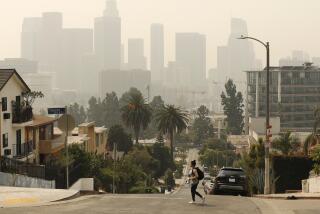Parent anger plays role in Japan’s reversal of raised radiation limits at schools
- Share via
Reporting from Tokyo — The parents were furious: Why, they demanded, had Japanese officials raised the acceptable level of radiation exposure for schoolchildren near the crippled Fukushima Daiichi nuclear power plant?
By upping the limit, children were allowed on playgrounds containing higher levels of radioactivity than had been permitted before the nearby atomic plant was damaged by the devastating March 11 earthquake and tsunami, the parents said. While it may be impossible to rid the air of dangerous isotopes, they added, the ground is a different matter.
At a government-convened meeting here this month, parents demanded that authorities reinstate stricter radioactivity standards and begin stripping the top layer of soil off contaminated playgrounds. But officials stood their ground. And in a nation where polite public discourse is the norm, the dialogue quickly turned hostile. A woman in the front row cut off one spokesman:
“In the playground, in the sandbox, children put dirt into their mouths! They breathe in the dust! You should do the same! Lick the dirt!” she shouted to applause. “You wouldn’t do this to your own kids!”
Under the new guidelines, the government set the upper limit of safe radiation exposure for children at 20 millisieverts per year, from 1 millisievert previously.
On Friday, Japan’s Education Ministry pulled an about-face, announcing plans to return exposure limits for children at school to 1 millisievert a year. Officials said they would also cover the cost of removing the surface soil from schoolyards where the limit is exceeded.
“We have taken the measure so children and their parents can feel relieved,” Education Minister Yoshiaki Takaki told a news conference.
Scientists say a cumulative dose of 500 millisieverts of radiation increases the risk of cancer and that children in the region of the plant consequently face a particularly high risk over the course of their lifetimes.
The government’s initial raising of the exposure limit for schoolchildren prompted one key nuclear advisor to quit in protest. At times fighting back tears, Toshio Kosako, a professor at the University of Tokyo and an expert on radiation exposure, told reporters in late April that he was against what he considered inappropriate radiation limits.
“I cannot allow this as a scholar,” said Kosako, who was appointed by Prime Minister Naoto Kan. “I feel the government response has been merely to bide time.”
In recent weeks, doctors and environmental groups had also weighed in with criticism. This month, Physicians for Social Responsibility, a U.S. nonprofit, blasted as “unconscionable” Japan’s radiation standards at schools in Fukushima prefecture.
David Lochbaum, director of the nuclear safety project at the Union of Concerned Scientists, another U.S. nonprofit, said the current danger was real. “If I were a parent of a child in school there, I wouldn’t be happy either,” he said. “The new limits do not mean that a child will develop leukemia in the next year, but it does pose an elevated risk.”
Twenty-one national lawmakers signed a petition this month condemning the new radiation exposure limits for children near the Fukushima plant. And some recent public protests have called for a shift away from nuclear energy.
As the debate raged, some cities took matters into their own hands. In Koriyama city, 40 miles west of the stricken Fukushima Daiichi plant, officials found high radiation levels for playgrounds at many schools. They hired bulldozers to scrape the top layer of soil from playgrounds at 67 day-care centers, elementary schools and junior high schools.
The move lowered radiation levels by between 40% and 90%, according to results posted on the city’s website. “We decided not to wait for guidance from the central government,” said Hiroshi Nozaki, a Koriyama board of education official.
On Monday, hundreds of demonstrators braved a steady drizzle in Tokyo to protest the government’s policy, holding signs that said “The government kills people” and “Adults are responsible.”
Afterward, in a hallway at a government ministry where the protesters gathered, Saori Kanzawa tended to her daughter Riko, a 4-year-old with pins holding her bangs and Little Mermaid socks.
The family fled Koriyama city for Tokyo, worried about radiation from the ailing nuclear plant. “Had we stayed at home, we would have had to tell Riko that she can’t go to this park or play on that slide,” said Kanzawa, 32.
“It’s impossible to know how the radiation would affect Riko in the next five to 10 years or longer. She may want to have children in the future, and as parents we have to do everything we can to limit her risk of radiation exposure.”
Hall is a special correspondent based in Tokyo.
More to Read
Sign up for Essential California
The most important California stories and recommendations in your inbox every morning.
You may occasionally receive promotional content from the Los Angeles Times.











